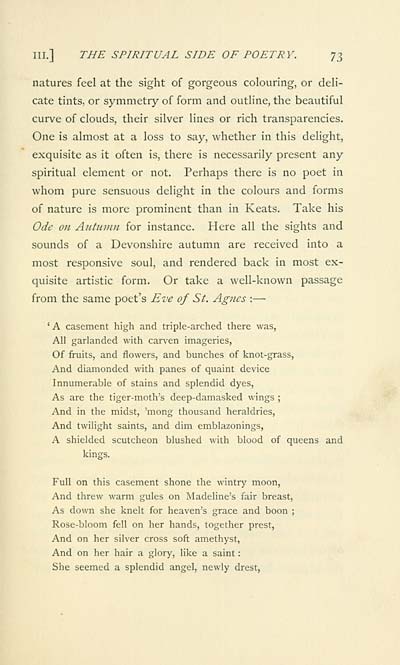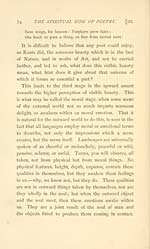Download files
Complete book:
Individual page:
Thumbnail gallery: Grid view | List view

111.] THE SPIRITUAL SIDE OF POETRY. ']^
natures feel at the sight of gorgeous colouring, or deli-
cate tints, or symmetry of form and outline, the beautiful
curve of clouds, their silver lines or rich transparencies.
One is almost at a loss to say, whether in this delight,
exquisite as it often is, there is necessarily present any
spiritual element or not. Perhaps there is no poet in
whom pure sensuous delight in the colours and forms
of nature is more prominent than in Keats. Take his
Ode on Autwnn for instance. Here all the sights and
sounds of a Devonshire autumn are received into a
most responsive soul, and rendered back in most ex-
quisite artistic form. Or take a well-known passage
from the same poet's Eve of St. Agnes : —
'A casement high and triple-arched there was,
All garlanded with carven imageries,
Of fruits, and flowers, and bunches of knot-grass,
And diamonded with panes of quaint device
Innumerable of stains and splendid dyes.
As are the tiger-moth's deep-damasked wings ;
And in the midst, 'mong thousand heraldries,
And twilight saints, and dim emblazonings,
A shielded scutcheon blushed with blood of queens and
kings.
Full on this casement shone the wintry moon.
And threw warm gules on Madeline's fair breast,
As down she knelt for heaven's grace and boon ;
Rose-bloom fell on her hands, together prest.
And on her silver cross soft amethyst,
And on her hair a glory, like a saint :
She seemed a splendid angel, newly drest,
natures feel at the sight of gorgeous colouring, or deli-
cate tints, or symmetry of form and outline, the beautiful
curve of clouds, their silver lines or rich transparencies.
One is almost at a loss to say, whether in this delight,
exquisite as it often is, there is necessarily present any
spiritual element or not. Perhaps there is no poet in
whom pure sensuous delight in the colours and forms
of nature is more prominent than in Keats. Take his
Ode on Autwnn for instance. Here all the sights and
sounds of a Devonshire autumn are received into a
most responsive soul, and rendered back in most ex-
quisite artistic form. Or take a well-known passage
from the same poet's Eve of St. Agnes : —
'A casement high and triple-arched there was,
All garlanded with carven imageries,
Of fruits, and flowers, and bunches of knot-grass,
And diamonded with panes of quaint device
Innumerable of stains and splendid dyes.
As are the tiger-moth's deep-damasked wings ;
And in the midst, 'mong thousand heraldries,
And twilight saints, and dim emblazonings,
A shielded scutcheon blushed with blood of queens and
kings.
Full on this casement shone the wintry moon.
And threw warm gules on Madeline's fair breast,
As down she knelt for heaven's grace and boon ;
Rose-bloom fell on her hands, together prest.
And on her silver cross soft amethyst,
And on her hair a glory, like a saint :
She seemed a splendid angel, newly drest,
Set display mode to: Large image | Transcription
Images and transcriptions on this page, including medium image downloads, may be used under the Creative Commons Attribution 4.0 International Licence unless otherwise stated. ![]()
| Early Gaelic Book Collections > Ossian Collection > Aspects of poetry > (89) |
|---|
| Permanent URL | https://digital.nls.uk/78386340 |
|---|
| Description | Selected books from the Ossian Collection of 327 volumes, originally assembled by J. Norman Methven of Perth. Different editions and translations of James MacPherson's epic poem 'Ossian', some with a map of the 'Kingdom of Connor'. Also secondary material relating to Ossianic poetry and the Ossian controversy. |
|---|
| Description | Selected items from five 'Special and Named Printed Collections'. Includes books in Gaelic and other Celtic languages, works about the Gaels, their languages, literature, culture and history. |
|---|

